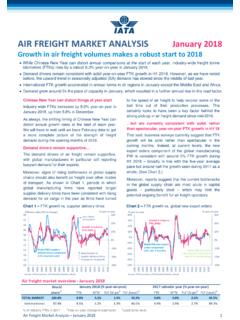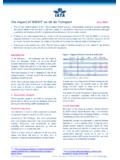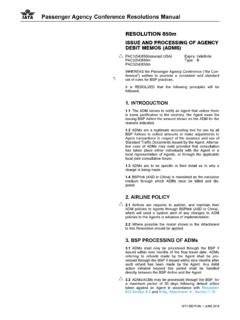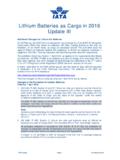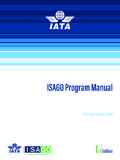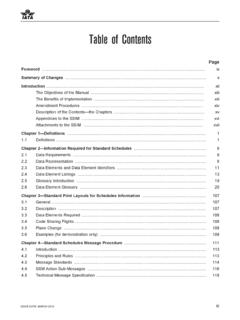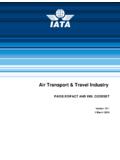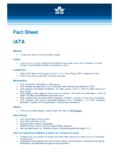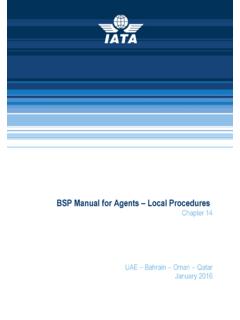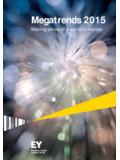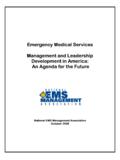Transcription of Future of Aviation Industry 2035 - IATA - Home
1 1 Future OF THE AIRLINE Industry 2035 About IATAThe International Air Transport Association (IATA) is the trade association for the world s airlines, representing some 265 airlines or 83% of total air traffic. We support many areas of Aviation activity and help formulate Industry policy on critical Aviation issues. IATA is led by Alexandre de Juniac, Director General & CEO since September SOIFS chool of International Futures (SOIF) is an independent strategic foresight consultancy set up to enhance the capacity of business leaders, policy-makers, governments and international organizations to use and gain value from horizon scanning and foresight. We help organizations think differently and more confidently about the Future .
2 International Air Transport Association 20173 ForewordDear Reader,Thank you for joining us on this journey into the Future . We hope you find the report a thought-provoking and insightful read into the factors which may shape the air transport Industry in the years to come. IATA s Industry Affairs Committee (IAC), a group of 20 airline heads of government affairs, commissioned this study with the aim of anticipating the key risks and opportunities global commercial Aviation will face between now and 2035. Like many other industries, Aviation tends to focus on addressing immediate challenges , as opposed to engaging in deep reflection as to what the Future holds and how it might affect the Industry or particular that in mind, the Committee had three specific goals in mind when commissioning this study: Anticipate the opportunities and challenges the Industry will face, and take actions to address them today.
3 As arguably the most global of industries, the externalities international air transport faces are numerous. From geopolitics to technological innovation, demographic shifts to environmental concerns, the winds of change buffeting the Industry can come from many directions. Understanding the potential landscape in which airlines find themselves is therefore critical to ensuring that Aviation can grow sustainably in the Future and maximize its potential to deliver the economic and social benefits that greater connectivity brings. Facilitate similar discussions at an airline and alliance level. It is our hope that our airline members and their alliances, as the case may be will see value in this study and use it to reflect on how they will be affected by Future developments.
4 How will their specific regulatory and business environments be changed by the trends we ve discussed here? How can alliances address the risks, and take advantage of the opportunities , that some of these trends may give rise to? Partner with governments to lay the groundwork for sustainable air connectivity growth ideally through the establishment of national air transport strategies. By planning for changes that lie ahead using internationally accepted smarter regulation principles, governments can ensure that their economies and societies will reap the benefits of increased connectivity and position Aviation as a key contributor to the 2030 United Nations Sustainable Development Goals.
5 The Industry seeks to be a strategic partner in that journey, and we look forward to exchanging views with our colleagues in government on what the trends described herein mean for their specific countries and regions and how best to address report is meant to be the start of an ongoing discussion on how to ensure that Aviation continues to be in the business of freedom, now and in the Future . With that in mind, do share your insights, thoughts and feedback at of the airline industryiv1 Executive SummaryWhat should airlines be thinking about, and what steps should they start taking today to be ready for the opportunities and challenges of the next 20 years?
6 This report sets out the findings of a study exploring the forces shaping the Future of Aviation , and looks at the potential implications for the airline Industry . It was commissioned by IATA s Industry Affairs Committee (IAC) carried out by School of International Futures (SOIF), and informed by exchanges with the airline Industry and external challenges are always on the horizon. It s hard to find an Industry that hasn t at some point been knocked sideways by unexpected developments or changes in the rules. Change can be sudden and overwhelming, or gradual and unnoticed; in either case the result can be hard to manage and sometimes fatal for organizations not actively preparing for as newspapers, the music Industry and taxi companies have discovered is a common source of disruption.
7 But drivers of change can also be political and regulatory, social and economic not forgetting environmental factors and policies designed to address more concrete terms, do you know who your customers will be in 2035? What routes will you fly? Will you determine the schedules, or will your customers, or your government, or the neural network of the IT services compa-ny that now owns you? Will you be a global environmental pariah, or will you be the Industry that made a huge effort to clean up its act, at the same time creating jobs and helping pull millions out of poverty?The good news is that, while the Future is unpredictable, there are steps we can take to be better prepared for what it may bring.
8 As an Aviation community, armed with an analysis of Future trends and acting with a common purpose you can take steps to influence how the Future unfolds. And as a commercial player in the airline Industry , you can add these insights to your strategic thinking to gain a competitive edge. With this in mind, we started by exploring the question: What are the key drivers of change that IATA and airlines should be thinking about to prepare for Future opportunities and challeng-es over the next 20 years? We cast a wide net to identify sources of change, drivers, trends and other weak signals that would impact the Industry s Future operating environment. We explored and prioritized these with the IAC and Industry to develop alternative scenarios for the sector and surfaced a set of implications and recommenda-tions, issues that IATA can start to engage with overview of the project is provided overleaf in Figure 1.
9 The main steps were: Interviews and Horizon Scan (Section 2) Prioritization of drivers of change and theme develop-ment (Section 3) Scenario development (Section 4) Implications and recommenda-tions (Section 5)Our recommendations are collected together in Annex D. But the main purpose of the report is to get you to think about what these changes will mean for your OVERVIEWHORIZON SCAN AND INTERVIEWS TO IDENTIFY DRIVERS OF CHANGE A series of interviews was held with global trend specialists and experts in other fields, as well as Aviation experts. Material from the interviews was taken together with a literature review and horizon scan to identify a list of 50 drivers of change (for information see Section 2 for the full driver list see Annex E)PRIORTIZATION OF DRIVERS OF CHANGE AND THEMESAn online assessment was conducted IATA Industry Affairs Committee andapproximately 500 industryprofessionals* to gather Industry views on the most important and uncertain drivers of change (see Section 3).
10 Drivers were then grouped into 11 themes important issues to explore during scenario development (for information see Section 4). SCENARIO DEVELOPMENTFour contrasting scenarios were developed for the Industry out to 2035. See Section 5 for how this was done, and the resulting scenario OF IMPLICATIONS AND RECOMMENDATIONS A set of implications was generated from a wind-tunnelling exercise, additional exploration of the scenarios, and inputs from the horizon scan and interviews. A selection of recommendations are presented in Section 6, issues that are important for IATA and its members to engage with and steps that they can start taking now to prepare for OF CHANGETHEMESD efence priorities dominate civilian needsRising sea levels and reclaimed habitatsShifting ethnic, political and religious identityTerrorismInfectious disease and pandemicsGeopolitical instabilityRise of populist movementsResource nationalismShifting borders.
